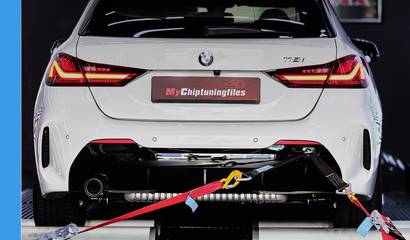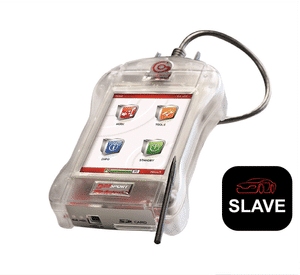Sunday 16 November

If you've been into cars for a while, or even just recently started poking around the world of performance mods, you've probably heard about ECU tuning. Maybe you’ve even done it yourself. But what a lot of people don’t realize is how far this whole tuning scene has come over the years. It's not just about soldering chips onto circuit boards anymore, or adjusting a few knobs on a piggyback controller. We’ve gone from crude hacks to insanely advanced digital remapping that can fine-tune every single parameter of a modern engine.
So if you're curious about how we got here, this post is for you. We’re going to walk through how ECU tuning started, what it used to look like, and where it is now—with a few detours into the stuff that changed the game. Whether you're just getting started or you've already got your own tuned project car, it's good to know where all this came from.
Let’s go back to the beginning.
The Early Days: Mechanical Tuning and Carb Adjustments
Before ECUs were even a thing, tuning was a purely mechanical job. We're talking about carburetors, distributor timing, air/fuel screws—old-school stuff. Back then, if you wanted to squeeze out more performance, you had to literally get your hands dirty. You adjusted jets, swapped cams, played with ignition curves by manually twisting the distributor cap.
That kind of tuning took real experience. It was more of an art than a science. You didn’t have data logs or digital graphs. You had your ears, your nose (for unburnt fuel), and seat-of-the-pants feel. Was the car bogging down? Was it knocking under load? Was the spark plug fouled?
That was tuning in the old days. And while it had its charm, it was also limited—especially as engines and emissions systems started getting more complex.
The Birth of the ECU
In the late 1970s and early '80s, things started to change. Emissions regulations were tightening up, and car manufacturers needed a way to control engine operation more precisely. Enter the ECU—the engine control unit. Basically, it’s a small computer that manages the engine's fuel delivery, ignition timing, and later on, things like variable valve timing, turbo boost, and more.
At first, these ECUs were pretty simple. They used analog circuits or early digital chips to monitor sensors and control actuators. But even back then, enthusiasts saw an opportunity. If you could tweak what the ECU was doing, you could get more power out of the engine—just like with carb tuning, but now through electronics.
This is when the first real wave of ECU tuning began.
Also Read: Future Innovations: The Role of AI in Transforming the Driving Experience
Chipping: The First Wave of ECU Tuning
In the '80s and early '90s, ECU tuning was mostly about replacing or modifying the actual chip inside the ECU. This process was literally called “chipping.”
You'd take the ECU out, crack it open, and either replace the EPROM (Erasable Programmable Read-Only Memory) with a new one, or solder on a socket that let you swap in pre-programmed chips. These chips had different maps—fuel, ignition, sometimes even speed limiters—designed to boost performance.
It wasn’t super flexible. You couldn’t make custom changes unless you had the tools to edit the binary files (which very few people had). Most folks just bought performance chips off the shelf from companies that had done the work for them.
This was cool at the time, but there were limitations. You couldn't really tune your own car unless you had a very specific skill set. And once the chip was in, you had to hope it matched your exact setup—any changes to hardware might throw things off.
Still, this was a massive step forward. For the first time, you could improve your car’s performance using software changes alone.
The Rise of OBD and Flash Tuning
The real game-changer came in the late '90s and early 2000s, when OBD2 became the standard across most vehicles. OBD2 (On-Board Diagnostics, version 2) was introduced to make emissions testing easier and more standardized, but it had a side effect that tuners loved—it gave easier access to the ECU.
Instead of cracking the ECU open, you could now connect to it through the diagnostic port using specialized tools. This is where “flash tuning” was born.
With flash tuning, tuners could read the factory map from the ECU, modify it using tuning software, and then reflash it back onto the ECU. No soldering. No chip swapping. Just plug and play. This was huge.
You also had the ability to create custom tunes for individual cars. Want to run 91 octane instead of 87? No problem. Added a turbo kit? You could adjust your fuel and timing maps to support it. Switched to bigger injectors? Just tune for them. This opened up an entirely new world of performance tuning—and more people than ever could get in on the action.
The Boom of Tuning Software and DIY Culture
As OBD2 flash tuning tools became more available, so did the software to edit the ECU maps. Programs like HP Tuners, EcuTek, COBB Accessport, and TunerPro (just to name a few) gave enthusiasts the power to modify their own ECUs at home.
You could datalog engine performance, adjust maps, and refine your tune over time. Forums were booming with base maps, tutorials, and shared tuning strategies. Tuners started building reputations online, offering remote tuning services where they’d send you a file, you’d flash it to your ECU, log the results, and they’d tweak it from there.
This was the golden era of grassroots ECU tuning.
Some platforms even saw entire subcultures grow around tuning. Think of the Honda scene, the Subaru crowd, or the VW/Audi community—each with their own quirks, tools, and tuning approaches.
Advancements in Engine Tech = More Complicated Tuning
As car technology improved, so did the complexity of engine management. Modern ECUs now manage everything from direct injection to multi-stage variable valve timing, drive-by-wire systems, adaptive learning, active exhausts, and even transmission behavior.
This added a ton of power and efficiency from the factory, but it also made tuning way more complicated. You’re no longer just tweaking a fuel table. Now you’ve got to manage a dozen interconnected systems that all talk to each other.
For example, changing the boost level on a modern turbo engine might require:
- Adjusting turbo wastegate duty cycle maps
- Managing intake air temperature corrections
- Scaling the mass airflow sensor
- Modifying torque limiter maps
- Accounting for knock control and timing corrections
- Coordinating with automatic transmission behavior
It’s a puzzle. But modern tuning software keeps up. Tools now include real-time tuning, built-in safety features, and better compatibility with factory ECUs. The learning curve is steeper, but the results are better than ever.
Custom vs. Generic Tunes
With advanced tuning tools came more tuning options. Some companies offered off-the-shelf tunes—files pre-built for specific cars and mods. These are quick and easy, but not always the best fit.
Custom tuning, on the other hand, means adjusting the ECU to match your specific setup. Maybe you’ve got a catless downpipe, an upgraded intercooler, different injectors, or a big turbo. A custom tune will account for all of that. It takes more time, and usually some back-and-forth with a tuner, but the end result is smoother, safer, and more powerful.
And now, remote tuning has gotten really sophisticated. You can send logs, get revisions, and dial in your car without ever stepping into a dyno shop—though dyno tuning still gives the most accurate numbers if you’re chasing the edge.
Also Read: Is Chip Tuning Safe for Your Car? What You Should Know
Emissions, Lockdowns, and Tuning Limits
One major challenge tuners face now is encryption and lockdowns on modern ECUs. A lot of manufacturers have started to protect their software more aggressively—either to prevent tampering or meet emissions requirements. Some ECUs are "locked" from the factory, which means tuning them requires unlocking tools or hardware mods that are risky or expensive.
Plus, stricter emissions laws have made it harder to tune certain components without throwing codes or failing inspections. Removing DPFs, EGR valves, or catalytic converters can trip fault codes, cause dash lights, or even put the car into limp mode.
Tuning around these systems—while possible—requires careful work and a deep understanding of the car's logic.
Still, where there's a will, there’s a way. Tuners continue to find new methods, and aftermarket companies are always pushing back with updated tools, cable kits, and tuning suites that can get into newer ECUs.
Where We Are Now
These days, ECU tuning is more powerful and accessible than ever. Whether you’re working with a bone-stock daily or a full-blown race build, you’ve got options.
- Flash tuning with handheld devices
- Custom remote tuning with revisions
- Live tuning on dynos
- Plug-and-play modules that modify signals in real time
- Flex-fuel tuning for E85 setups
- Multi-map switching on the fly
And now we’re starting to see integration with apps and cloud-based services. Some tuners offer mobile apps where you can switch maps, read codes, or log data using your phone.
It’s wild to think how far it’s come—from popping off a distributor cap to tapping a screen on your phone and uploading a new tune in minutes.
Take the First Step: Start a Chiptuning Business with Confidence
If you're ready to start a chiptuning business, having the right support makes all the difference. At MyChiptuningfiles, we provide everything you need to begin offering professional ECU tuning services with confidence—even if you're just starting out.
Our team of experienced engineers creates high-quality tuning files using trusted software like WinOLS. Every file is carefully crafted to deliver improved power, better fuel economy, and reliable performance, all while protecting the engine’s integrity. You don’t need to be an expert—we handle the technical work for you.
Just upload your original ECU file to our portal, and we’ll return a custom solution, ready to install. With quick turnaround, expert support, and a user-friendly process, you can focus on building your business while we handle the tuning side.
Whether you're a mechanic looking to expand your services or an entrepreneur entering the automotive space, MyChiptuningfiles is your reliable partner. Our consistent file quality and ongoing support help you build trust with your customers and grow your business with confidence.
Now’s the time to turn your interest into action. Start a chiptuning business today with MyChiptuningfiles—your partner in professional tuning solutions.
Final Thoughts
The evolution of ECU tuning mirrors the evolution of the car itself. What started as a hands-on, wrench-spinning craft has turned into a digital science. But underneath it all, the spirit is the same: making your car better, faster, more responsive, and more fun.
We’ve gone from soldering chips to logging boost curves in real time. From guessing jet sizes to calculating load values and timing advance. And the best part? We’re still just scratching the surface. As electric and hybrid vehicles gain ground, ECU tuning will change again—maybe not with fuel and spark, but with torque curves, battery management, and power delivery profiles.
So whether you're tuning an old-school turbo diesel or a brand-new performance hatchback, just know you're part of a long tradition of enthusiasts who’ve always wanted one thing: more out of their machine.
And with today’s tools and tech, we’ve got more ways than ever to get it.
news.related_news
Chiptuning tools
Whether you own a car, truck or tractor: we have the best equipment and software for tuning your petrol and diesel engine. With our chiptuning tools it is possible to easily read out the original engine software of your vehicle and upload it to our website. And then it's up to us to provide you with high-quality and customized chip tuning files. Curious about our range of chiptuning tools? Check it out via the button below!









